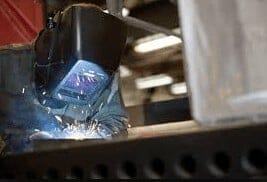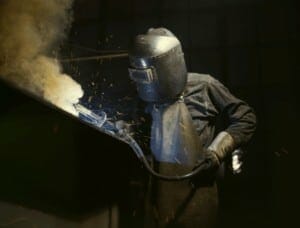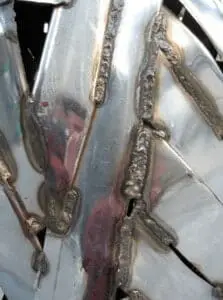If you ever wanted to get into metalwork, welding sheet metal is one of the most important things you will need to learn first. The importance of welding in many American industries cannot be understated, as welding remains strong in trade shops across all industries in America.
Sheet metal is fundamental to metalwork and learning how to weld sheet metal can be very useful for any projects involving cars or any architecture. By learning these techniques, it will be much easier for you to know how to weld sheet metal on a car. Our comprehensive guide will help you understand the different techniques for welding sheet metal.
We will go over different methods of welding, such as MIG and TIG welding and compare different types of weld. We will also address many potential problems with sheet metal welding and give useful tips on how to avoid those problems to make sure your next project involving welding sheet metal is as easy and headache-free as possible. It doesn’t matter whether if you’re not an expert, there are many ideal welders for novices.
If you are interested in custom metal parts, then we always advice going to an expert or professional in the industry. This will ensure a premium service.
Techniques for welding sheet metal
There are many techniques of welding that can be applied to welding sheet metal, but we will be focusing on two techniques: mig welding and tig welding.
Both of these are easy to apply and understand once you apply the proper procedures and use safety precautions.
Mig and tig welding can be used for more robust projects, that less-skilled methods like spot welding can not undertake, after fully understanding the method. Learning solely how to spot weld sheet metal may be useful in the beginning, but learning mig and tig techniques opens up the door for many new possibilities in the welding world.
Mig welding sheet metal
Mig welding (also known as Gas Metal Arc Welding) is geared more towards beginners, as it is a very common welding method amongst beginners. The sheet metal must be fully cleaned before starting the welding process to get the smoothest, best results.
There is a whole process in learning how to mig weld sheet metal. During mig welding, a solid wire electrode is fed through a welding gun towards a welding pool in order to fuse the base materials together. A shielding gas is used to protect the weld pool from possible contamination. The Mig process is relatively easy to pick up, if you follow relevant safety procedures and follow industry advice for equipment preparation
Mig is used by hobby welders, DIY welders and other welding enthusiasts frequently because many believe that this method of welding is the easiest to follow and pick up on. It’s also not that labor intensive, compared to other methods of welding.
Tig welding sheet metal
Tig welding (also known as Gas Tungsten Arc Welding) is another type of welding used for sheet metal. It can be used for very thin sheets of metal. The tungsten rods used can create a small, defined weld and the smallest electrode must be used to reduce any chances of contamination. Shorter arc lengths can produce a higher quality of welds.
Tig welding uses heat from the electric arc between an electrode and a heat torch between the metal being welded. The gap between an electrode and the heat torch must be very small in order to make sure that the heat allows the base materials to fuse together. The electric arc and molten metal are guarded by an inert gas, preventing the both electrode and metal from oxidizing. Tig welding can be used by beginning and intermediate welders alike, because of the versatility of the method.
Butt weld vs lap weld
Butt weld is a type of welding joint, which is a point where two or more pieces of metal are joined together. Butt welds are used for thin sheets of metal to make sure that the welding process can happen in a single pass.
Butt welding is done when you apply pressure and/or heat to two metals, allowing the metals to penetrate each other and join together due to the high heat.
Using butt welds, the strongest welds have the lowest amount of imperfections. Butt welding can be very efficient in large-scale industrial settings, especially in factories where automation is prevalent.
Lap welds are another type of welding joint which are most frequently used to join two or more pieces of metal with differing thicknesses from each other. A lap joint can be formed when multiple pieces of metal can placed in an overlapping position on top of each other.
Similar to butt welds, lap welds can also be used to join very thin sheets of metal together. An ideal lap weld should have substantial weld bead penetration so the overlapping sides don’t melt back onto each other, ruining the overlapping process.
Butt-welding sheet metal
Butt-welding sheet metal using either the TIG or MIG method can be crucial to create sturdy, reliable metal pieces that can be used to create any panel work for things like cars or buildings. Butt welding using the TIG or MIG method is very efficient due to their natural ability to connect two pieces of metal together. Butt welding sheet metal using different methods can help determine a weld’s properties like its resistance against corrosion and its overall strength and durability.
When butt-welding sheet metal, you should be aware of many of its intricacies to make sure that you are able to create the best piece of metal. Things like the width of the weld, the thinness of the metals, what type of gas to use for the heat and what type of wire to use are very important. Using the right equipment and following the proper procedure whilst using the right equipment.
Tack-weld patch panel in place
Tack-welding can be used as a temporary method to keep components together in one place, in an appropriate alignment and distance from the heat source during welding, until the final welding process can be completed. Tack-welding can be used to set up individual, specific workpieces for an overall full piece.
Tack-welds are often classified as short welds and they are made at some distance from each to hold edges of workpieces together.
Generally, tack-welding uses a similar process to final welding.
Tack-welding is beneficial as its temporary nature allows engineers to make any changes to the welding process, especially if things like the alignment was inaccurate. Tack-welding allows changes to happen fairly quickly and easily as workpieces can be disassembled and reassembled in no time.
Avoid warping the sheet metal
Although weld shrinkage of metal can’t be fully stopped, steps can be taken to avoid warping in parts of thin sheet metal. Warping can happen during weld when straight thin sheets of metal can warp in on itself, making joint weld difficult. To avoid warping the sheet metal, you shouldn’t overweld, rather weld intermittently. You should balance welds at a neutral axis and make fewer weld passes to minimize shrinkage and warping of the thin sheet metals.
Problems with welding sheet metal
There are many problems you must avoid while welding sheet metal if you want to make your life easier while welding metals together. The main problems with welding include warping, as discussed above, melt-through and excessive heat-affected zones.
It is a challenge to fix all these potential problems, while ensuring that the weld is maintaining enough strength for its desired applications. There is a trade-off between the quality of equipment and the potential quality of the weld that you must manage in order to make sure that problems like warping are avoided.
FAQs
1. What kind of welder do I need for sheet metal?
When welding sheet metal, MIG, pulsed MIG, TIG, and pulsed TIG are the best choices, when welding thin metal, the primary goal is to avoid warping, burn-through, and excessive heat-affected zones while maintaining sufficient mechanical strength for the application.
2. How do you keep sheet metal from warping when welding?
Welds should be placed close to the neutral axis or the center of the part. Reduce warpage by allowing shrinkage forces to pull the plates out of alignment with less leverage. Balance welds are those that are centered on the neutral axis. Welding on both sides of the plate balances out the shrinkage forces, thereby minimizing warpage.
3. What causes metal to warp when welding?
Even the most experienced welders encounter distortions/warping in their welds. This is because the metal expands and contracts in all directions as it is heated. Warping occurs as a result of these stresses in the metal.
4. How do welders keep metal cool?
Welding Heat Sink- Placing a heat sink behind the weld or on the surrounding metal of a weld helps keep the heat contained and allows you to weld without causing significant damage to the metal surrounding the weld.
5. What is used for flattening sheet metal?
Flattening sheet metal with a hammer and a flame requires considerable expertise and time. Hammer and honey – This method of leveling parts or sheets is still used in the metal fabrication industry. This technique flattens the sheet metal component with the aid of a hammer.




